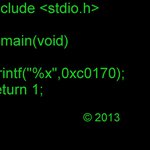mbed library sources
Dependents: Encrypted my_mbed lklk CyaSSL_DTLS_Cellular ... more
Superseded
This library was superseded by mbed-dev - https://os.mbed.com/users/mbed_official/code/mbed-dev/.
Development branch of the mbed library sources. This library is kept in synch with the latest changes from the mbed SDK and it is not guaranteed to work.
If you are looking for a stable and tested release, please import one of the official mbed library releases:
Import librarymbed
The official Mbed 2 C/C++ SDK provides the software platform and libraries to build your applications.
Diff: targets/cmsis/TARGET_STM/TARGET_STM32F4/stm32f4xx_hal_pwr.c
- Revision:
- 532:fe11edbda85c
- Parent:
- 380:510f0c3515e3
- Child:
- 613:bc40b8d2aec4
--- a/targets/cmsis/TARGET_STM/TARGET_STM32F4/stm32f4xx_hal_pwr.c Thu Apr 30 13:00:08 2015 +0100
+++ b/targets/cmsis/TARGET_STM/TARGET_STM32F4/stm32f4xx_hal_pwr.c Thu Apr 30 13:45:11 2015 +0100
@@ -2,8 +2,8 @@
******************************************************************************
* @file stm32f4xx_hal_pwr.c
* @author MCD Application Team
- * @version V1.1.0
- * @date 19-June-2014
+ * @version V1.3.0
+ * @date 09-March-2015
* @brief PWR HAL module driver.
* This file provides firmware functions to manage the following
* functionalities of the Power Controller (PWR) peripheral:
@@ -13,7 +13,7 @@
******************************************************************************
* @attention
*
- * <h2><center>© COPYRIGHT(c) 2014 STMicroelectronics</center></h2>
+ * <h2><center>© COPYRIGHT(c) 2015 STMicroelectronics</center></h2>
*
* Redistribution and use in source and binary forms, with or without modification,
* are permitted provided that the following conditions are met:
@@ -47,7 +47,7 @@
* @{
*/
-/** @defgroup PWR
+/** @defgroup PWR PWR
* @brief PWR HAL module driver
* @{
*/
@@ -56,16 +56,34 @@
/* Private typedef -----------------------------------------------------------*/
/* Private define ------------------------------------------------------------*/
+/** @addtogroup PWR_Private_Constants
+ * @{
+ */
+
+/** @defgroup PWR_PVD_Mode_Mask PWR PVD Mode Mask
+ * @{
+ */
+#define PVD_MODE_IT ((uint32_t)0x00010000)
+#define PVD_MODE_EVT ((uint32_t)0x00020000)
+#define PVD_RISING_EDGE ((uint32_t)0x00000001)
+#define PVD_FALLING_EDGE ((uint32_t)0x00000002)
+/**
+ * @}
+ */
+
+/**
+ * @}
+ */
/* Private macro -------------------------------------------------------------*/
/* Private variables ---------------------------------------------------------*/
/* Private function prototypes -----------------------------------------------*/
/* Private functions ---------------------------------------------------------*/
-/** @defgroup PWR_Private_Functions
+/** @defgroup PWR_Exported_Functions PWR Exported Functions
* @{
*/
-/** @defgroup PWR_Group1 Initialization and de-initialization functions
+/** @defgroup PWR_Exported_Functions_Group1 Initialization and de-initialization functions
* @brief Initialization and de-initialization functions
*
@verbatim
@@ -78,7 +96,7 @@
write accesses.
To enable access to the RTC Domain and RTC registers, proceed as follows:
(+) Enable the Power Controller (PWR) APB1 interface clock using the
- __PWR_CLK_ENABLE() macro.
+ __HAL_RCC_PWR_CLK_ENABLE() macro.
(+) Enable access to RTC domain using the HAL_PWR_EnableBkUpAccess() function.
@endverbatim
@@ -87,13 +105,12 @@
/**
* @brief Deinitializes the HAL PWR peripheral registers to their default reset values.
- * @param None
* @retval None
*/
void HAL_PWR_DeInit(void)
{
- __PWR_FORCE_RESET();
- __PWR_RELEASE_RESET();
+ __HAL_RCC_PWR_FORCE_RESET();
+ __HAL_RCC_PWR_RELEASE_RESET();
}
/**
@@ -101,7 +118,6 @@
* backup data registers and backup SRAM).
* @note If the HSE divided by 2, 3, ..31 is used as the RTC clock, the
* Backup Domain Access should be kept enabled.
- * @param None
* @retval None
*/
void HAL_PWR_EnableBkUpAccess(void)
@@ -114,7 +130,6 @@
* backup data registers and backup SRAM).
* @note If the HSE divided by 2, 3, ..31 is used as the RTC clock, the
* Backup Domain Access should be kept enabled.
- * @param None
* @retval None
*/
void HAL_PWR_DisableBkUpAccess(void)
@@ -126,7 +141,7 @@
* @}
*/
-/** @defgroup PWR_Group2 Peripheral Control functions
+/** @defgroup PWR_Exported_Functions_Group2 Peripheral Control functions
* @brief Low Power modes configuration functions
*
@verbatim
@@ -143,15 +158,16 @@
(+) A PVDO flag is available to indicate if VDD/VDDA is higher or lower
than the PVD threshold. This event is internally connected to the EXTI
line16 and can generate an interrupt if enabled. This is done through
- __HAL_PVD_EXTI_ENABLE_IT() macro.
+ __HAL_PWR_PVD_EXTI_ENABLE_IT() macro.
(+) The PVD is stopped in Standby mode.
- *** WakeUp pin configuration ***
+ *** Wake-up pin configuration ***
================================
[..]
- (+) WakeUp pin is used to wake up the system from Standby mode. This pin is
+ (+) Wake-up pin is used to wake up the system from Standby mode. This pin is
forced in input pull-down configuration and is active on rising edges.
- (+) There is only one WakeUp pin: WakeUp Pin 1 on PA.00.
+ (+) There is one Wake-up pin: Wake-up Pin 1 on PA.00.
+ Only for STM32F446xx there are two Wake-Up pins: Pin1 on PA.00 and Pin 2 on PC.13
*** Low Power modes configuration ***
=====================================
@@ -186,9 +202,9 @@
are preserved.
The voltage regulator can be configured either in normal or low-power mode.
To minimize the consumption In Stop mode, FLASH can be powered off before
- entering the Stop mode using the HAL_PWR_EnableFlashPowerDown() function.
+ entering the Stop mode using the HAL_PWREx_EnableFlashPowerDown() function.
It can be switched on again by software after exiting the Stop mode using
- the HAL_PWR_DisableFlashPowerDown() function.
+ the HAL_PWREx_DisableFlashPowerDown() function.
(+) Entry:
The Stop mode is entered using the HAL_PWR_EnterSTOPMode(PWR_MAINREGULATOR_ON)
@@ -214,18 +230,18 @@
(++) Entry:
(+++) The Standby mode is entered using the HAL_PWR_EnterSTANDBYMode() function.
(++) Exit:
- (+++) WKUP pin rising edge, RTC alarm (Alarm A and Alarm B), RTC wakeup,
+ (+++) WKUP pin rising edge, RTC alarm (Alarm A and Alarm B), RTC wake-up,
tamper event, time-stamp event, external reset in NRST pin, IWDG reset.
- *** Auto-wakeup (AWU) from low-power mode ***
+ *** Auto-wake-up (AWU) from low-power mode ***
=============================================
[..]
(+) The MCU can be woken up from low-power mode by an RTC Alarm event, an RTC
- Wakeup event, a tamper event or a time-stamp event, without depending on
- an external interrupt (Auto-wakeup mode).
+ Wake-up event, a tamper event or a time-stamp event, without depending on
+ an external interrupt (Auto-wake-up mode).
- (+) RTC auto-wakeup (AWU) from the Stop and Standby modes
+ (+) RTC auto-wake-up (AWU) from the Stop and Standby modes
(++) To wake up from the Stop mode with an RTC alarm event, it is necessary to
configure the RTC to generate the RTC alarm using the HAL_RTC_SetAlarm_IT() function.
@@ -234,8 +250,8 @@
is necessary to configure the RTC to detect the tamper or time stamp event using the
HAL_RTCEx_SetTimeStamp_IT() or HAL_RTCEx_SetTamper_IT() functions.
- (++) To wake up from the Stop mode with an RTC WakeUp event, it is necessary to
- configure the RTC to generate the RTC WakeUp event using the HAL_RTCEx_SetWakeUpTimer_IT() function.
+ (++) To wake up from the Stop mode with an RTC Wake-up event, it is necessary to
+ configure the RTC to generate the RTC Wake-up event using the HAL_RTCEx_SetWakeUpTimer_IT() function.
@endverbatim
* @{
@@ -250,52 +266,47 @@
* detection level.
* @retval None
*/
-void HAL_PWR_PVDConfig(PWR_PVDTypeDef *sConfigPVD)
+void HAL_PWR_ConfigPVD(PWR_PVDTypeDef *sConfigPVD)
{
- uint32_t tmpreg = 0;
-
/* Check the parameters */
assert_param(IS_PWR_PVD_LEVEL(sConfigPVD->PVDLevel));
assert_param(IS_PWR_PVD_MODE(sConfigPVD->Mode));
- tmpreg = PWR->CR;
-
- /* Clear PLS[7:5] bits */
- tmpreg &= ~ (uint32_t)PWR_CR_PLS;
-
/* Set PLS[7:5] bits according to PVDLevel value */
- tmpreg |= sConfigPVD->PVDLevel;
+ MODIFY_REG(PWR->CR, PWR_CR_PLS, sConfigPVD->PVDLevel);
- /* Store the new value */
- PWR->CR = tmpreg;
-
- /* Configure the EXTI 16 interrupt */
- if((sConfigPVD->Mode == PWR_MODE_IT_RISING_FALLING) ||\
- (sConfigPVD->Mode == PWR_MODE_IT_FALLING) ||\
- (sConfigPVD->Mode == PWR_MODE_IT_RISING))
+ /* Clear any previous config. Keep it clear if no event or IT mode is selected */
+ __HAL_PWR_PVD_EXTI_DISABLE_EVENT();
+ __HAL_PWR_PVD_EXTI_DISABLE_IT();
+ __HAL_PWR_PVD_EXTI_DISABLE_RISING_EDGE();
+ __HAL_PWR_PVD_EXTI_DISABLE_FALLING_EDGE();
+
+ /* Configure interrupt mode */
+ if((sConfigPVD->Mode & PVD_MODE_IT) == PVD_MODE_IT)
{
- __HAL_PVD_EXTI_ENABLE_IT(PWR_EXTI_LINE_PVD);
+ __HAL_PWR_PVD_EXTI_ENABLE_IT();
+ }
+
+ /* Configure event mode */
+ if((sConfigPVD->Mode & PVD_MODE_EVT) == PVD_MODE_EVT)
+ {
+ __HAL_PWR_PVD_EXTI_ENABLE_EVENT();
}
- /* Clear the edge trigger for the EXTI Line 16 (PVD) */
- EXTI->RTSR &= ~EXTI_RTSR_TR16;
- EXTI->FTSR &= ~EXTI_FTSR_TR16;
- /* Configure the rising edge */
- if((sConfigPVD->Mode == PWR_MODE_IT_RISING_FALLING) ||\
- (sConfigPVD->Mode == PWR_MODE_IT_RISING))
+
+ /* Configure the edge */
+ if((sConfigPVD->Mode & PVD_RISING_EDGE) == PVD_RISING_EDGE)
{
- EXTI->RTSR |= PWR_EXTI_LINE_PVD;
+ __HAL_PWR_PVD_EXTI_ENABLE_RISING_EDGE();
}
- /* Configure the falling edge */
- if((sConfigPVD->Mode == PWR_MODE_IT_RISING_FALLING) ||\
- (sConfigPVD->Mode == PWR_MODE_IT_FALLING))
+
+ if((sConfigPVD->Mode & PVD_FALLING_EDGE) == PVD_FALLING_EDGE)
{
- EXTI->FTSR |= PWR_EXTI_LINE_PVD;
+ __HAL_PWR_PVD_EXTI_ENABLE_FALLING_EDGE();
}
}
/**
* @brief Enables the Power Voltage Detector(PVD).
- * @param None
* @retval None
*/
void HAL_PWR_EnablePVD(void)
@@ -305,7 +316,6 @@
/**
* @brief Disables the Power Voltage Detector(PVD).
- * @param None
* @retval None
*/
void HAL_PWR_DisablePVD(void)
@@ -314,31 +324,37 @@
}
/**
- * @brief Enables the WakeUp PINx functionality.
+ * @brief Enables the Wake-up PINx functionality.
* @param WakeUpPinx: Specifies the Power Wake-Up pin to enable.
* This parameter can be one of the following values:
* @arg PWR_WAKEUP_PIN1
+ * @arg PWR_WAKEUP_PIN2 only available in case of STM32F446xx devices
* @retval None
*/
void HAL_PWR_EnableWakeUpPin(uint32_t WakeUpPinx)
{
/* Check the parameter */
assert_param(IS_PWR_WAKEUP_PIN(WakeUpPinx));
- *(__IO uint32_t *) CSR_EWUP_BB = (uint32_t)ENABLE;
+
+ /* Enable the wake up pin */
+ SET_BIT(PWR->CSR, WakeUpPinx);
}
/**
- * @brief Disables the WakeUp PINx functionality.
+ * @brief Disables the Wake-up PINx functionality.
* @param WakeUpPinx: Specifies the Power Wake-Up pin to disable.
* This parameter can be one of the following values:
* @arg PWR_WAKEUP_PIN1
+ * @arg PWR_WAKEUP_PIN2 only available in case of STM32F446xx devices
* @retval None
*/
void HAL_PWR_DisableWakeUpPin(uint32_t WakeUpPinx)
{
/* Check the parameter */
assert_param(IS_PWR_WAKEUP_PIN(WakeUpPinx));
- *(__IO uint32_t *) CSR_EWUP_BB = (uint32_t)DISABLE;
+
+ /* Disable the wake up pin */
+ CLEAR_BIT(PWR->CSR, WakeUpPinx);
}
/**
@@ -367,6 +383,9 @@
assert_param(IS_PWR_REGULATOR(Regulator));
assert_param(IS_PWR_SLEEP_ENTRY(SLEEPEntry));
+ /* Clear SLEEPDEEP bit of Cortex System Control Register */
+ CLEAR_BIT(SCB->SCR, ((uint32_t)SCB_SCR_SLEEPDEEP_Msk));
+
/* Select SLEEP mode entry -------------------------------------------------*/
if(SLEEPEntry == PWR_SLEEPENTRY_WFI)
{
@@ -385,7 +404,7 @@
/**
* @brief Enters Stop mode.
* @note In Stop mode, all I/O pins keep the same state as in Run mode.
- * @note When exiting Stop mode by issuing an interrupt or a wakeup event,
+ * @note When exiting Stop mode by issuing an interrupt or a wake-up event,
* the HSI RC oscillator is selected as system clock.
* @note When the voltage regulator operates in low power mode, an additional
* startup delay is incurred when waking up from Stop mode.
@@ -403,25 +422,15 @@
*/
void HAL_PWR_EnterSTOPMode(uint32_t Regulator, uint8_t STOPEntry)
{
- uint32_t tmpreg = 0;
-
/* Check the parameters */
assert_param(IS_PWR_REGULATOR(Regulator));
assert_param(IS_PWR_STOP_ENTRY(STOPEntry));
- /* Select the regulator state in Stop mode ---------------------------------*/
- tmpreg = PWR->CR;
- /* Clear PDDS and LPDS bits */
- tmpreg &= (uint32_t)~(PWR_CR_PDDS | PWR_CR_LPDS);
-
- /* Set LPDS, MRLVDS and LPLVDS bits according to Regulator value */
- tmpreg |= Regulator;
-
- /* Store the new value */
- PWR->CR = tmpreg;
+ /* Select the regulator state in Stop mode: Set PDDS and LPDS bits according to PWR_Regulator value */
+ MODIFY_REG(PWR->CR, (PWR_CR_PDDS | PWR_CR_LPDS), Regulator);
/* Set SLEEPDEEP bit of Cortex System Control Register */
- SCB->SCR |= SCB_SCR_SLEEPDEEP_Msk;
+ SET_BIT(SCB->SCR, ((uint32_t)SCB_SCR_SLEEPDEEP_Msk));
/* Select Stop mode entry --------------------------------------------------*/
if(STOPEntry == PWR_STOPENTRY_WFI)
@@ -432,10 +441,12 @@
else
{
/* Request Wait For Event */
+ __SEV();
+ __WFE();
__WFE();
}
/* Reset SLEEPDEEP bit of Cortex System Control Register */
- SCB->SCR &= (uint32_t)~((uint32_t)SCB_SCR_SLEEPDEEP_Msk);
+ CLEAR_BIT(SCB->SCR, ((uint32_t)SCB_SCR_SLEEPDEEP_Msk));
}
/**
@@ -446,16 +457,15 @@
* Alarm out, or RTC clock calibration out.
* - RTC_AF2 pin (PI8) if configured for tamper or time-stamp.
* - WKUP pin 1 (PA0) if enabled.
- * @param None
* @retval None
*/
void HAL_PWR_EnterSTANDBYMode(void)
{
/* Select Standby mode */
- PWR->CR |= PWR_CR_PDDS;
-
+ SET_BIT(PWR->CR, PWR_CR_PDDS);
+
/* Set SLEEPDEEP bit of Cortex System Control Register */
- SCB->SCR |= SCB_SCR_SLEEPDEEP_Msk;
+ SET_BIT(SCB->SCR, ((uint32_t)SCB_SCR_SLEEPDEEP_Msk));
/* This option is used to ensure that store operations are completed */
#if defined ( __CC_ARM)
@@ -468,25 +478,23 @@
/**
* @brief This function handles the PWR PVD interrupt request.
* @note This API should be called under the PVD_IRQHandler().
- * @param None
* @retval None
*/
void HAL_PWR_PVD_IRQHandler(void)
{
- /* Check PWR exti flag */
- if(__HAL_PVD_EXTI_GET_FLAG(PWR_EXTI_LINE_PVD) != RESET)
+ /* Check PWR Exti flag */
+ if(__HAL_PWR_PVD_EXTI_GET_FLAG() != RESET)
{
/* PWR PVD interrupt user callback */
HAL_PWR_PVDCallback();
/* Clear PWR Exti pending bit */
- __HAL_PVD_EXTI_CLEAR_FLAG(PWR_EXTI_LINE_PVD);
+ __HAL_PWR_PVD_EXTI_CLEAR_FLAG();
}
}
/**
* @brief PWR PVD interrupt callback
- * @param None
* @retval None
*/
__weak void HAL_PWR_PVDCallback(void)
@@ -497,6 +505,56 @@
}
/**
+ * @brief Indicates Sleep-On-Exit when returning from Handler mode to Thread mode.
+ * @note Set SLEEPONEXIT bit of SCR register. When this bit is set, the processor
+ * re-enters SLEEP mode when an interruption handling is over.
+ * Setting this bit is useful when the processor is expected to run only on
+ * interruptions handling.
+ * @retval None
+ */
+void HAL_PWR_EnableSleepOnExit(void)
+{
+ /* Set SLEEPONEXIT bit of Cortex System Control Register */
+ SET_BIT(SCB->SCR, ((uint32_t)SCB_SCR_SLEEPONEXIT_Msk));
+}
+
+/**
+ * @brief Disables Sleep-On-Exit feature when returning from Handler mode to Thread mode.
+ * @note Clears SLEEPONEXIT bit of SCR register. When this bit is set, the processor
+ * re-enters SLEEP mode when an interruption handling is over.
+ * @retval None
+ */
+void HAL_PWR_DisableSleepOnExit(void)
+{
+ /* Clear SLEEPONEXIT bit of Cortex System Control Register */
+ CLEAR_BIT(SCB->SCR, ((uint32_t)SCB_SCR_SLEEPONEXIT_Msk));
+}
+
+/**
+ * @brief Enables CORTEX M4 SEVONPEND bit.
+ * @note Sets SEVONPEND bit of SCR register. When this bit is set, this causes
+ * WFE to wake up when an interrupt moves from inactive to pended.
+ * @retval None
+ */
+void HAL_PWR_EnableSEVOnPend(void)
+{
+ /* Set SEVONPEND bit of Cortex System Control Register */
+ SET_BIT(SCB->SCR, ((uint32_t)SCB_SCR_SEVONPEND_Msk));
+}
+
+/**
+ * @brief Disables CORTEX M4 SEVONPEND bit.
+ * @note Clears SEVONPEND bit of SCR register. When this bit is set, this causes
+ * WFE to wake up when an interrupt moves from inactive to pended.
+ * @retval None
+ */
+void HAL_PWR_DisableSEVOnPend(void)
+{
+ /* Clear SEVONPEND bit of Cortex System Control Register */
+ CLEAR_BIT(SCB->SCR, ((uint32_t)SCB_SCR_SEVONPEND_Msk));
+}
+
+/**
* @}
*/
 mbed official
mbed official





